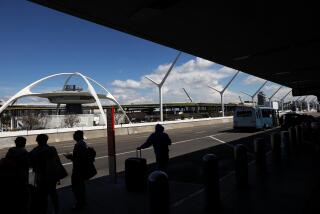FAA Urged to Speed Up Wind Radar Plans : Aviation: In wake of Charlotte crash, airport operators say new technology is crucial. Land acquisition fights have delayed the project.
WASHINGTON — As investigators try to determine the cause of Saturday’s plane crash in Charlotte, N.C., several airport operators called on the Federal Aviation Administration to pick up the pace on its plans to install advanced radar systems specially designed to detect dangerous wind conditions such as those that may have doomed USAir Flight 1016.
Charlotte-Douglas International Airport is 38th on the FAA’s list of 47 airfields to receive the system, known as terminal Doppler weather radar, which would provide air traffic controllers with a clearer picture of approaching thunderstorms and would measure changes in wind velocity.
Congress authorized the agency to buy and install the $2.5-million units six years ago. Ten of them have been built, but none of them are fully on line. Charlotte’s radar is expected to be in commission in June, 1996.
The FAA did not include any Southern California airports on the list because the area is not as prone to thunderstorms as other parts of the country.
“I think the FAA is responsive, but it takes too long with almost everything that it does,” said Charlotte airport manager Jerry Orr. “The acquisition process is fairly long and drawn out, and this is no exception.”
Investigators, after analyzing cockpit voice recorders and other data, are still trying to piece together what drove the jet, which was trying to abort its first landing attempt when it crashed, into the ground. But they point to wind shear, sudden downdrafts that can deprive planes of airspeed, as a likely culprit.
Existing weather measurement technology, such as Charlotte’s low-level wind shear alert system, is badly in need of replacement, several aviation experts said.
The basic low-level system, composed of six sensors placed around the airport, measures wind speed. But it cannot identify areas in the sky where aircraft are most likely to encounter microbursts, the most dangerous form of wind shear, and does not provide tower controllers with a graphic picture of inclement weather systems.
A senior FAA official said the program to acquire the more sophisticated system has been delayed nationwide because the agency has encountered problems in buying land needed to install the radar systems, including at the Charlotte airport. Each unit is built into a 100-foot tower and sits on an acre of land eight to 12 miles from the airport.
Landowners have haggled over prices. Environmentalists have objected. Citizens have complained about the possible dangers of radar beams in their back yards.
Early delays prompted the FAA to roll back the deadline for installing the new system nationwide to mid-1996. It originally had been slated for completion this winter.
FAA spokesmen refused to comment on whether Saturday’s crash would accelerate installation of the radar systems.
The FAA has already canceled or scaled back several components of its $7-billion program to modernize the nation’s air traffic control system, including the Advanced Automation System, a computer network designed to help control towers keep better track of aircraft. But the $373-million Doppler radar system has not run into obstacles so far. Congress awarded the agency $25 million for the units in this year’s budget, an increase over the $5.8 million appropriated last year.
Several airport operators said that the disaster in Charlotte highlights the need to keep up with technological advancements.
“As the technology emerges, it ought to be pursued,” said Tom Kinton, director of aviation for Boston’s Logan Airport. “It’s something we would definitely push for and have pushed for.”
More to Read
Inside the business of entertainment
The Wide Shot brings you news, analysis and insights on everything from streaming wars to production — and what it all means for the future.
You may occasionally receive promotional content from the Los Angeles Times.










